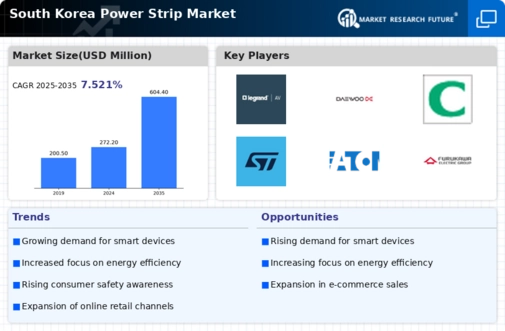Expansion of Smart Homes
The trend towards smart home technology in South Korea is significantly influencing the power strip market. As more consumers invest in smart devices, the need for compatible power solutions becomes apparent. In 2025, it is estimated that over 30% of households will have integrated smart home systems, which often require specialized power strips to accommodate various devices. This shift not only enhances convenience but also drives innovation within the power strip market, as manufacturers develop products that cater to the unique needs of smart home users. The integration of smart technology into power strips may also lead to increased sales and market growth.
Rising Demand for Electronics
The increasing reliance on electronic devices in South Korea is a primary driver for the power strip market. As households and businesses adopt more gadgets, the need for reliable power solutions escalates. In 2025, the number of electronic devices per household is projected to reach an average of 10, which necessitates the use of power strips to manage multiple connections. This trend is particularly evident in urban areas, where space constraints make power strips an essential accessory. The power strip market is likely to benefit from this growing demand, as consumers seek efficient ways to power their devices without compromising on safety or convenience.
Urbanization and Space Constraints
The rapid urbanization in South Korea is reshaping living environments, leading to increased demand for compact and multifunctional power solutions. As more individuals reside in smaller apartments, the need for efficient use of space becomes paramount. The power strip market is likely to see growth as consumers seek power strips that offer multiple outlets in a compact design. In 2025, it is projected that sales of space-saving power strips will rise by 15%, driven by urban dwellers' preferences. This trend highlights the importance of adaptability in product design, as manufacturers strive to meet the evolving needs of consumers in densely populated areas.
Regulatory Standards and Compliance
The power strip market in South Korea is influenced by stringent regulatory standards aimed at ensuring product safety and performance. Compliance with these regulations is essential for manufacturers to gain consumer trust and market access. In 2025, it is expected that new safety standards will be introduced, further shaping the power strip market. Companies that prioritize compliance and invest in quality assurance are likely to gain a competitive edge. This focus on regulatory adherence not only enhances product reliability but also fosters innovation, as manufacturers develop advanced features to meet evolving safety requirements.
Increased Focus on Energy Efficiency
Energy efficiency is becoming a critical consideration for consumers in South Korea, impacting the power strip market. With rising energy costs and growing environmental awareness, consumers are seeking products that minimize energy consumption. The power strip market is responding by offering energy-efficient models that reduce standby power usage. In 2025, it is anticipated that energy-efficient power strips will account for approximately 25% of total sales, reflecting a shift in consumer preferences. This trend not only aligns with governmental initiatives promoting energy conservation but also positions the power strip market as a key player in the broader sustainability movement.






















Leave a Comment